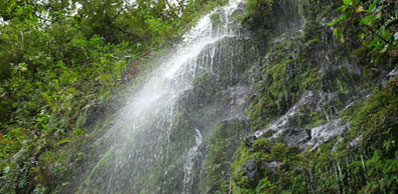From Cusco it's a 5 hr drive through Paucartambo to Tres Cruces, a lookout point which sits above the clouds at 4,200m/13780ft. From this "mirador" it's a descent of 3500m/11483ft down the eastern slope of the Andes to the beginning of the Amazon rainforest to Pilcopata at 700m/2297ft. The cloud forest is thick with fog, slippery and wet with persistent precipitation. It begins above the treeline the nturns to scrub followed by ferns and bromeliads, flowering plants, vines and bamboo. This is home to high jungle species such as the spectacled bear, deer, trogons, quetzals, motmots, eagles, wooley monkeys and Peru's national bird the "Cock of the Rock". There are a multitude of 100ft+ waterfalls, creeks and whitewater at the basins. The famous "Manu Road" which switchbacks through the canyons is known by birders worldwide for the access it provides to high jungle species. This road reaches the town of Pilcopata located at the beginning of the "Mother of God" River.
KML file (Opens with Google Earth)
Duration
Difficulty
EXP Required
Walking Dist.
Rap Heights
Rapids Class
Raft Dist Total
Water Quality
Bugs?
5-10D
3-5 of 5
Canyoning/Rap
16-40km/10-25mi
6-43m/20-140ft
2+
>29km/18mi
Clear
Less
Day 1-2 Cusco - Paucartambo - Tres Cruces
From Cusco it's a 3 hr drive to Paucartambo and another 1 hr up to the Acjanaco Pass at 3502m/11489ft. We can briefly use the provided restroom and take pictures at the Manu National Park sign before a 12km/7.5mi walk out to the guard shack at the Tres Cruces Mirador viewpoint. Tonight we camp at Tres Cruces with possible views of the Amazon below depending on the weather.
Day 2-10 Tres Cruces - Manu Road - Cosñipata River - Pilcopata
This morning we will again have possibilities of fantastic views high above the jungle and Manu National Park. The following 4 - 9 days will involve strategic descents using mainly tree anchors. There are no bolted top rope anchors. This area is not known for climbing or canyoning. After 1-2 days we will reach the Manu Road where cars frequently pass by making a transfer a possible option. It is also possible to walk down the road to the next rap which would take us further down to the Cosñipata River. From there we can walk downriver until it becomes navigable by packraft and after a few days reach the town of Pilcopata. It is also possible to walk back up to the Manu Road from the river if water levels are too low. As a group we will decide on the best route using satellite imagery and a 2-3 day hike down the Manu Road or private car day trip. From Pilcopata it's a 3.5 hr ride back up to Tres Cruces.
 Manu National Park Cloud Forest
Manu National Park Cloud Forest
Cost Estimates
From Cusco it's about $40 round trip to Pilcopata by local bus. A private van up and down the Manu Road from Pilcopata is about $70-$80. There are no entrance fees for this trip. There are no fees for our agency for any of these expeditionary trips. There are no guide fees and also no guarantees on return times, points of interest or the assurance of any planned activities.
Gear
For this trip you will need to provide your own canyoning, camping and packrafting gear including harness, carabiners, ropes, device, bug hammock, tarp, cooking equipment, packraft, paddles, helmet etc. In the case that you will not be providing your own camping equipment or cooking equipment we can rent these items. We do not rent packrafts but do rent other packrafting gear. We can also provide meals although cooking will be shared by the group. I recommmend hammocks as opposed to tent due to the sloped terrain. Our first night will be flat and a tarp setup should be sufficient. In the unlikely case of any bugs at Tres Cruces, your bug hammock can be configured on the ground underneath your tarp (a-frame configuration). This would eliminate the need for a separate tent in addition to a hammock/tarp setup.
Experience
You should be self-sufficient as a canyoneer and very confident in your rappelling. Your safety is in your own hands. Previous hammock camping experience is helpful but not neccesary. Previous experience in a tropical setting is also very helpful. Please have at least class 3 rafting experience if planning on rafting. The rivers do not mellow out until reaching Pilcopata or the Madre de Dios River.
Risks
High jungle can get cold and extended time in higher elevation waterfalls and creeks can be a potential risk. Keeping your change of clothes and sleeping bag dry is neccesary. Visibility can be bad for the upper 1/3 section or above 7000ft. Canyoneering is dangerous and more so in a foggy and perpetually wet environment with dense foliage and obstacles to work around. The route will be well-scouted and each rap carefully planned out ahead of time. I am not looking for especially long rappels or technical descents but a future route for beginners which could offer unique views of the forest through high jungle species' habitats. We offer no guarantees for any of these expeditions for planned activites, definite costs or for your absolute safety.
Highlights
High jungle is almost entirely different from lower elevations. Both plant and animal species can be specific to certain altitudes and with the use of ropes we can potentially reach unexplored areas.